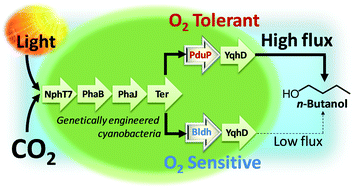In a recent paper in Energy & Environmental Science, UCLA Parsons Foundation Professor James C. Liao and his lab report the metabolic engineering of cyanobacteria to efficiently produce photosynthetic n-butanol.

Ethanol is great for many reasons, but n-butanol is a better target for renewable fuel systems, as it can be blended seamlessly into the current fossil fuel infrastructure. Unfortunately for synthetic biologists, the microbe that best produces n-butanol is a strict anaerobe, while the cyanobacterial photosynthetic machinery is responsible for the better part of the molecular oxygen in Earth’s atmosphere (For the record, this blogger is in favor of cyanobacterial oxygen evolution).
The authors of this paper find a clever way around this fundamental incompatability by using a different, air-tolerant enzyme for a key step in the biosynthetic pathway. A propionaldehyde oxidation catalyst (PduP) demonstrated catalytic reduction of butyryl-CoA to n-butyraldehyde, which could subsequently be converted to n-butanol. This is just one of 7 enzymes from 7 different organisms functioning in concert to produce the photosynthetic butanol. Much of this process has been previously been reported by the Liao group.
The challenges in stitching together these genomes are enormous. After all, no enzyme works in a vacuum (no offense, computationalists), and getting the right cocktail of expressed enzymes and complementary cofactors requires well-engineered organisms. Even the best systems have yields discussed in milligrams per liter per day. And even then, the butanol produced is toxic to the cells that make it.
Using synthetic biology to properly engineer these organisms will render them hardly recognizable. The challenges are daunting, but the possibilities seem limitless. By combining enzymes from many different organisms, each evolved over billions of years for efficient catalysis, or even human-designed enzymes tailored to exotic new schemes, metabolic engineers could produce stripped-down microbial factories to fuel our transportation and synthesize fine chemicals. Perhaps, given the diversity of life and biochemistry on Earth, microbial engineering could one day be used to bioterraform the solar system for human colonization! Well, I can dream, right?
Read Liao and co-workers’ article in EES:
Oxygen-tolerant coenzyme A-acylating aldehyde dehydrogenase facilitates efficient photosynthetic n-butanol biosynthesis in cyanobacteria
Ethan I. Lan, Soo Y. Ro and James C. Liao
DOI: 10.1039/C3EE41405A











